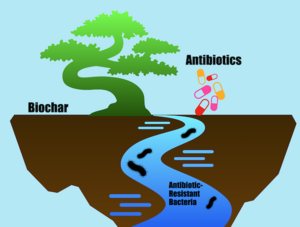
Water is one of the world’s most valued commodities, and antibiotic-resistant bacteria are one of the emerging pollutants of concern. The World Health Organization predicts that if no preventative action is taken, antimicrobial resistant infections will kill more people than cancer by the year 2050. This problem is also projected to disproportionately affect low-income communities which may be reliant upon stormwater. Stormwater runoff picks up pollutants such as chemicals, bacteria, and sediment as it runs over impervious surfaces and into waterbodies. The aim of this project is to test the use of biochar columns as an effective and inexpensive form of stormwater treatment. Biochar is biomass that has undergone pyrolysis. It serves as an adsorbent for contaminants in water including antibiotic-resistant bacteria. It is commonly used in land applications as a soil amendment, but there are concerns as to how long biochar is effective and what occurs once the biochar is saturated. Three infiltration columns were tested; one containing biochar, one with soil and biochar mixed in a ratio typically seen in a soil amendment, and one with soil. Due to the unpredictability of stormwater, semi-natural stormwater was synthesized by inoculating stormwater collected from the OSU-Benton County Green Stormwater Infrastructure Research Facility with a strain of non-pathogenic E. coli. Using culture-based methods, E. coli in the synthetic stormwater was quantified before and after treatment through. The ability of the columns to both remove and retain an adequate concentration of E. coli was analyzed. All three mediums were able to successfully remove up to 3 logs of E. coli. The preliminary data suggests that biochar is a more effective adsorbent than plain soil. Future tests will focus on biofilm formation as well as the variability of antibiotic-resistant bacteria’s fate in infiltration columns. Additionally, the media itself will be analyzed to determine its effects on bacterial growth within the column. The end goal will be to determine the best step for future use of biochar.
